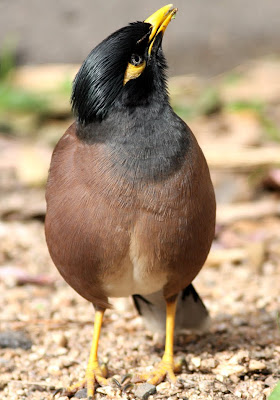 Rainbow Lorikeet
Rainbow Lorikeet
So we finally left North America after three memorable months, via the (pleasingly sci-fi) L.A.X, on the afternoon of the 9th; a 15-hour flight and a crossing of the international date line later, and it was shortly after dawn on the 11th in Sydney, New South Wales, Australia.
 Currawong Vs Kookaburra
Currawong Vs Kookaburra
Heavily jetlagged, through customs and into the cool, antipodean winter air, we cabbed from the airport to our basecamp for the next week - a lovely apartment in the very heart of the city, in the thick of the action by Kings Cross station. All courtesy of good-friend-of-a-good-friend Maxine, who by beautiful co-oincidence happened to be house-sitting in the suburbs for the week, and a set of keys later, there we were....

 Common Mynas
Common Mynas
Attempts at catching up on sleep failed miserably, and so to our first priority - hunting down an Australian field guide*. Once nailed, a quick lunch back at the homestead and then our first visit to a place we'd fail to tire of over the coming days,
The Royal Botanic Gardens.

 White-faced Heron
White-faced Heron
A fifteen minute stroll away, this lush, well-maintained, dog-free, wildlife-friendly park on the harbour front provided plenty of top-class entertainment; so much in fact that the opera house, however impressive in the flesh, was most often ignored and came a poor second to the wildlife....

 Silver Gull
Silver Gull
....despite occupying the western 'finger' of the park. It also served as a useful distraction for channeling the main flow of tourists away from the area - not that the sometimes ridiculously human-friendly fauna seemed to care anyway.
 Figbird
Figbird
After registering the often raucous, trash-plundering, ultra-tame birds on the city streets -
Australian White Ibises nonchalantly wandering amongst the human and vehicular traffic, and
Common Mynas,
Sulphur-crested Cockatoos and
Silver Gulls exploiting backpackers and locals alike - the park yielded a stream of exotic and approachable species (all lifers) during our debut wander.


 Noisy Miners
Noisy Miners
Even accounting for inexperience and inevitable misses, the afternoon clocked up twenty new species, including gangs of psychotic
Noisy Miners, musical
Figbirds, odd corvid-type
Pied Currawongs and
Australian Magpies, new hirundines
Welcome Swallows and
Tree Martins, very tame
Dusky Moorhens,
Pacific Black Ducks and
Australian Wood Ducks, a single
White-faced Heron,



explosion-in-a-paint-factory
Rainbow Lorikeets, flyover
Pied Cormorant and
White-headed Pigeon, a kingfisher-like
Grey Butcherbird, characterful and accommodating
Laughing Kookaburras, and the bizarrely inquisitive, ground-breeding
Masked Lapwings, most with mobile young, and all as bold as brass on the park's footpaths and grass.
 Dusky Moorhen
Dusky Moorhen
A perfect way to gain an introduction to the local, essentially alien avifauna; also a chance to enjoy the park's infamous, impressive colony of x-thousand
Grey-headed Flying Foxes (megabats, literally), of which, more to follow.

 Australian Wood Ducks
Australian Wood Ducks
*An interesting conundrum of our travels in general has been the issue of field guides - more than essential for enjoying each country's birds, but proportionately heavy and cumbersome for the very limited space within the backpack; not an issue for a several week-long trip to one or two countries, but a real problem for eight months round the world....
 flyover White-headed Pigeon
flyover White-headed Pigeon
It also depends on which to bring / seek out - Japan, for example, inexplicably lacks an accurate, up-to-date field guide, and the best bet is Mark Brazil's thankfully comprehensive
Birds of East Asia, which is the only guide that's travelling with me from start to finish.
 Australian White Ibis, a.k.a. bin-bird
Australian White Ibis, a.k.a. bin-bird
For North America, the respective
Sibley for East and West were ideal, portable, and have been dispatched back to Blighty after serving their purpose and becoming reassuringly dog-eared in the process.
 Pacific Black Duck
Pacific Black Duck
For Australia, however, not quite so simple. Staying for just a week (and confined to a corner of New South Wales at that), to have carted around a field guide for the preceding three months would've made no sense, and so improvisation was needed. Ideally, picking one up in L.A. - a major hub and with (presumably) suitably large and/or specialist book stores - with a good week or so in hand to research before hitting Australia would be a realistic proposition....
Not so, and after exhausting all possibilities there, I had to admit defeat. Non-birders reading this are probably thinking, no big deal; international birders, however, will empathise with how impotent and blind it feels to arrive on a new continent armed with sweet F.A. in the regional bible department.
 Australian Magpie
Australian Magpie
And so, as soon after landing as possible, we hit the big bookstores in town, selected the most appropriate (unfortunately Australia has no stand-out, definitive guide, but three or four with their own pros and cons), and from thereon, it's all about trying not to get too overwhelmed too soon, being methodical and enjoying new birds as they come, and accepting the fact that a larger than usual proportion will slip through the net early on.

 trouble on the way
trouble on the way




























































